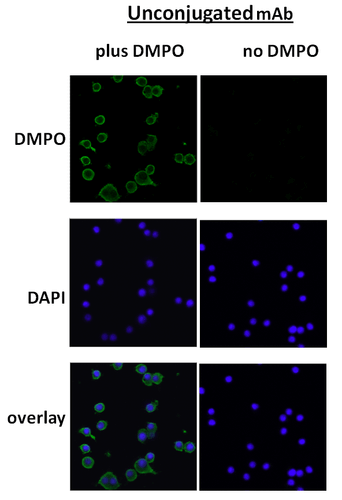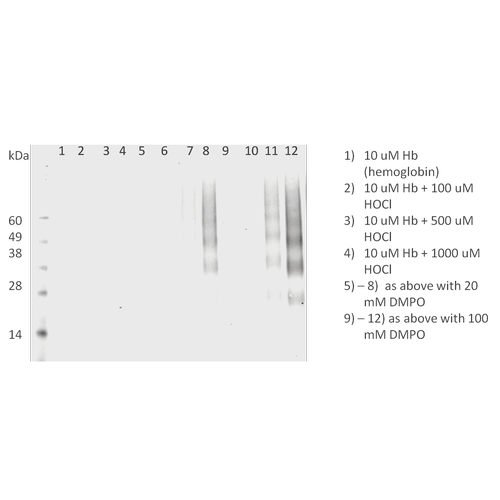Anti-DMPO Nitrone Adduct Antibody (12531)
Anti-DMPO Nitrone Adduct Antibody (12531)
Product No.: 12531
- -
- -
Clone N1664A Target DMPO Nitrone Adduct Formats AvailableView All Product Type Monoclonal Isotype Mouse IgG1 Applications ELISA , ICC , IF , IHC , IP , WB , AM |
Data
 Immunocytochemistry/Immunofluorescence analysis using Mouse Anti-DMPO Monoclonal Antibody, Clone N1664A (12531). Tissue: macrophage cell line (Raw 264.7). Species: Mouse. Primary Antibody: Mouse Anti-DMPO Monoclonal Antibody (12531) at 1:100. Secondary Antibody: Alexa Fluor 488 Goat Anti-Mouse (green) at 1:1000. Counterstain: DAPI (blue) nuclear stain.
Immunocytochemistry/Immunofluorescence analysis using Mouse Anti-DMPO Monoclonal Antibody, Clone N1664A (12531). Tissue: macrophage cell line (Raw 264.7). Species: Mouse. Primary Antibody: Mouse Anti-DMPO Monoclonal Antibody (12531) at 1:100. Secondary Antibody: Alexa Fluor 488 Goat Anti-Mouse (green) at 1:1000. Counterstain: DAPI (blue) nuclear stain. - -
- -
Antibody DetailsProduct DetailsReactivity Species All Host Species Mouse Immunogen 5,5-dimethyl-2-(8-octanoic acid)-1-pyrrolone-N-oxide conjugated to ovalbumin. Product Concentration Lot Specific Formulation PBS, pH 7.4, 50% glycerol, 0.09% sodium azide. State of Matter Liquid Product Preparation Purified by Protein G affinity chromatography Storage and Handling This antibody is stable for at least one (1) year at -20°C. Avoid multiple freeze-thaw cycles. Regulatory Status For in vitro investigational use only. Not for use in therapeutic or diagnostic procedures. Country of Origin USA Shipping Next Day 2-8°C Applications and Recommended Usage? Quality Tested by Leinco Immunoblotting: use at 1-10ug/mL.
Immunofluorescence: use at10ug/mL. These are recommended concentrations; Enduser should determine optimal concentrations for their applications ELISA: use at 1-10ug/mL Positive control: DMPO nitrone adducts of metmyoglobin. Each investigator should determine their own optimal working dilution for specific applications. See directions on lot specific datasheets, as information may periodically change. DescriptionSpecificity This antibody recognizes DMPO, DMPO-octanoic acid, DMPO-protein adducts, and DMPO-DNA adducts. It does not cross-react with non-adducted proteins or DNA. Species independent. Background Free radicals are highly reactive and generally short-lived species. Hence, most studies of free radicals have been restricted to analysis of end products formed following their interaction with cellular biomolecules. One technology that has permitted direct study of free radicals is electron spin resonance (ESR). For very short lived radicals, spin traps have been employed to generate longer lived radicals that are more amenable to ESR analysis. The most widely used of these spin traps is 5,5-dimethyl-1-pyrroline-N-oxide (DMPO). The reaction of DMPO with a protein radical gives rise to a nitroxide radical which can be disproportionate to hydrozylamine and nitrone adducts. Of these species, only the nitrone adduct can be considered stable. Antigen DetailsResearch Area DNA References & CitationsTechnical Protocols |



